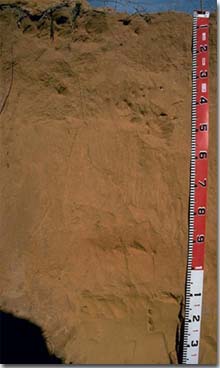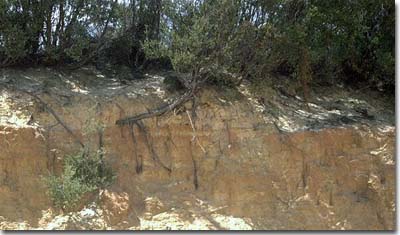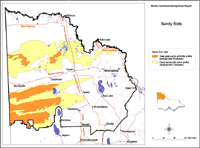Sandy Soils
Sandy Soils are widespread in the Mallee region. Those that are calcareous throughout are discussed in the Calcarosols section. The sandy soils covered here include Tenosols and Rudosols. Tenosols are weakly developed soils whilst Rudosols display minimal development and tend to be younger.
| Sandy Soils in the Mallee Region This map of Sandy Soils in the Mallee region has been developed by Jim Rowan and is based on the Land Systems of Victoria (1:250 000). It shows areas where Sandy Soils (Rudosols and Tenosols) are most likely to occur within the region and should only be used as a general indication of their distribution. Please note that other soil types may also occur within these mapped areas. Sandy Soils may occur in areas not mapped here, however, these are most likely to be minor occurrences. Sandy Calcarosols are covered in the Calcarosols section. |
 A Rudosol that occurs in some younger Big Desert dunes near Walpeup. |
The pale aeolian sands of the Big Desert are similar to the east-west belt of land in the Sunset Country, to the north of the Ouyen-Murrayville settlement. It is thought to have originated as coastal sands when the seas retreated westwards from the Murray Gulf. Part of these areas have high parabolic dunes with wide intervening sand plains, apparently formed in a recent period of wind activity. There is little soil development apart from weak surface accumulation of organic matter. The loose off-white sands have low fertility and a high wind erosion hazard. |
 A Tenosol with argic horizons associated with older dunes in the Big Desert. |
Interspersed with the previous landscape are east-west belts of land with closely spaced east-west dunes. There is some subsoil (B) horizon development, indicating an older landscape than the previous one supporting Rudosols. The pale surface (A) horizons are deep loose sands. The subsoil (B) horizons are somewhat compact, reddish in colour, and have some accumulation of clay in the subsoil (sometimes forming an argic horizon). Fertility is low and wind hazard high. |



